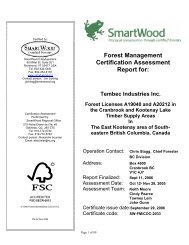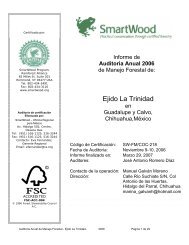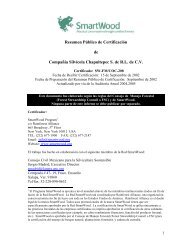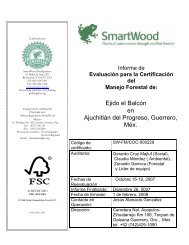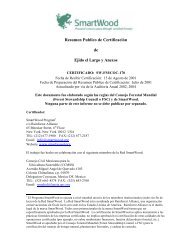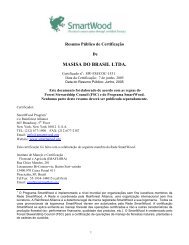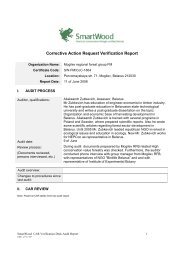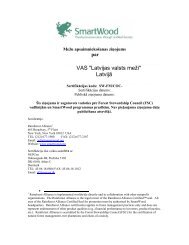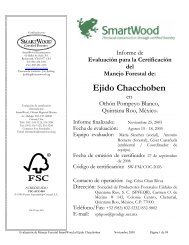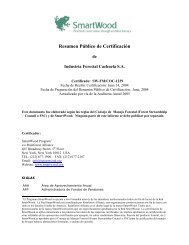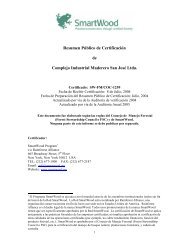[C] The Hidden Frontier of Forest Degradation - Rainforest Alliance
[C] The Hidden Frontier of Forest Degradation - Rainforest Alliance
[C] The Hidden Frontier of Forest Degradation - Rainforest Alliance
You also want an ePaper? Increase the reach of your titles
YUMPU automatically turns print PDFs into web optimized ePapers that Google loves.
SUMMARY FOR POLICY & PRACTICE<br />
» <strong>Degradation</strong> emissions represent at least 20 percent <strong>of</strong> total tropical forest emissions. This estimate is based on a review <strong>of</strong> regional estimates<br />
from all three major tropical forest zones (Amazonia, Congo basin, Southeast Asia) which find that degradation emissions represent from 20 to 57<br />
percent <strong>of</strong> total emissions from deforestation and degradation.<br />
» <strong>Degradation</strong> emissions appear to represent (i) the majority <strong>of</strong> emissions from tropical forests in Africa, and (ii) a magnitude similar to deforestation<br />
in tropical Asia.<br />
» Global estimates referenced by the IPCC Assessment Report 4 appear to underestimate emissions from degradation due to technical limitations<br />
<strong>of</strong> global estimates to date. Work is needed to (i) improve the consistency <strong>of</strong> methods used to estimate degradation emissions, and (ii)<br />
improve the accuracy <strong>of</strong> global estimates.<br />
» <strong>Degradation</strong> <strong>of</strong>ten increases the likelihood <strong>of</strong> deforestation. Thus, including emissions from degradation in a REDD mechanism is important<br />
not only to address direct emissions resulting from degradation, but also to link incentives for mitigation towards the first steps in a chain <strong>of</strong> events<br />
leading to deforestation.<br />
Estimates <strong>of</strong> the amount <strong>of</strong> global emissions from tropical<br />
forest degradation vary by almost an order <strong>of</strong> magnitude.<br />
Studies referenced by the Intergovernmental Panel on<br />
Climate Change (IPCC) Fourth Assessment Report (Nabuurs<br />
et al., 2007) estimate that forest degradation emissions represent<br />
4.4 percent (Achard et al., 2004) to seven to nine percent<br />
(Houghton, 2003; DeFries et al., 2002) <strong>of</strong> total tropical forest<br />
carbon emissions. In contrast, a recent study attributes about 35<br />
percent <strong>of</strong> tropical forest emissions to legal selective logging<br />
alone (0.51 Gt C/yr), in just the 20 percent <strong>of</strong> tropical forests<br />
identified as “production estate” by the International Tropical<br />
Timber Organization (Putz et al., 2008).<br />
<strong>Degradation</strong> from Logging<br />
Logging is the only type <strong>of</strong> forest degradation with global tropical<br />
emissions estimates (Putz et al. 2008, Houghton 2003).<br />
Tropical Asia was identified by Putz et al. (2008) as the<br />
largest source <strong>of</strong> logging emissions. New methods to detect<br />
selective logging activities (Asner et. al. 2005), and partial<br />
canopy fire (Souza et. al. 2005), have revolutionized the<br />
detection <strong>of</strong> degradation emissions (Curran et al., 2006);<br />
however these methods have not yet been applied globally.<br />
Asner et al. (2005) determined that emissions from selective<br />
logging in major portions <strong>of</strong> the Brazilian Amazon add up to<br />
0.08 GtC to the atmosphere each year, increasing the estimated<br />
gross annual anthropogenic flux <strong>of</strong> carbon from Amazonian<br />
forests by 25 percent over carbon losses from deforestation<br />
(Figure 1). It was also found that annual logging activities<br />
cover an area similar in size to the area deforested each year.<br />
<strong>The</strong>se new analytical methods have thus revealed that selective<br />
logging represents about 20 percent <strong>of</strong> emissions from<br />
degradation and deforestation in the Amazon region 3 .<br />
FIGURE 1. Spatial distribution <strong>of</strong> selective logging in five timber-production states <strong>of</strong><br />
the Brazilian Amazon for the year intervals 1999 (red), 2000-2001 (blue), and 2001-<br />
2002 (green). <strong>The</strong> states <strong>of</strong> Amazonas (AM), Amapa (AP), Tocantins (TO), Maranhao<br />
(MA), and the southern non-forested part <strong>of</strong> Mato Grosso were not included in the<br />
analysis. Light grey areas show the extent <strong>of</strong> indigenous reserves; dark grey areas<br />
delineate federal conservation lands as <strong>of</strong> 1999. RR, Roraima; PA, Pará; MT, Mato<br />
Grosso; RO, Rondônia; AC, Acre. This figure is reproduced, with permission <strong>of</strong> the<br />
authors, from Asner et. al. 2005.<br />
<strong>Degradation</strong> from Fuelwood Harvest<br />
It is clear that fire and fuelwood harvest, though not yet<br />
measured globally, represent two other major sources <strong>of</strong><br />
degradation emissions. Fuelwood harvesting accounts for 40<br />
percent <strong>of</strong> global removal <strong>of</strong> wood from forests according to<br />
the FAO (2006); however, it is not yet clear how to translate<br />
this activity to actual greenhouse gas emissions caused by fuelwood<br />
harvesting. An analysis by Gaston et al. (1998) concluded<br />
3<br />
We arrive at this “about 20 percent” figure simply by adding the Asner et. al. (2005) estimate <strong>of</strong> selective logging emissions to deforestation emissions. It appears that Asner et.<br />
al.(2005) have accounted for the average annual area logged that is subsequently deforested in generating their 0.08 GtC value (they find that 19% <strong>of</strong> the total area logged was subsequently<br />
deforested three years later).<br />
T H E H I D D E N F R O N T I E R O F F O R E S T D E G R A D A T I O N $ 9


![[C] The Hidden Frontier of Forest Degradation - Rainforest Alliance](https://img.yumpu.com/30611265/13/500x640/c-the-hidden-frontier-of-forest-degradation-rainforest-alliance.jpg)
